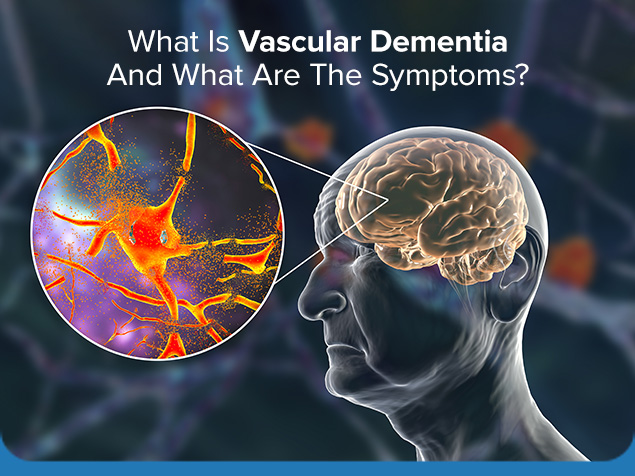Vascular dementia is the second most common form of dementia after Alzheimer’s disease, resulting from impaired blood flow to the brain. The condition arises due to damage in cerebral vessels, typically from strokes or small vessel disease, which compromises oxygen and nutrient delivery to brain tissue. The resulting neuronal injury leads to cognitive decline, memory loss, and behavioral disturbances.
Vascular dementia often presents with sudden or stepwise deterioration, distinguishing it from the gradual progression seen in other dementia types.

Causes and Risk Factors of Vascular Dementia
Primary Causes
- Ischemic Stroke: A major cause where blood clots obstruct cerebral arteries.
- Hemorrhagic Stroke: Bleeding within the brain damages surrounding neural structures.
- Small Vessel Disease (Binswanger’s Disease): Progressive narrowing of cerebral arterioles affecting deep brain tissue.
- Transient Ischemic Attacks (TIAs): Repeated mini-strokes lead to cumulative damage.
- Post-Cardiac Events: Hypoperfusion following cardiac arrest or severe arrhythmias.
Risk Factors
- Hypertension
- Atrial fibrillation
- Diabetes mellitus
- Hyperlipidemia
- Smoking
- Obesity
- History of stroke or cardiovascular disease
- Advanced age
Symptoms of Vascular Dementia
The symptoms vary depending on the region and extent of brain damage. They often present abruptly following a stroke or may develop progressively in chronic vascular injury.
Cognitive Symptoms
- Impaired judgment and planning
- Slowed thought processing
- Memory deficits (often less severe than in Alzheimer’s)
- Difficulty concentrating or organizing tasks
Behavioral and Psychological Symptoms
- Depression and apathy
- Emotional instability
- Anxiety or agitation
- Hallucinations (less common)
Neurological and Physical Symptoms
- Muscle weakness or paralysis
- Gait disturbances
- Urinary incontinence
- Dysphasia or speech difficulties
Types of Vascular Dementia
Multi-Infarct Dementia
Resulting from multiple strokes in various brain regions. The symptoms tend to be stepwise, with sudden declines after each infarct.
Subcortical Vascular Dementia
Associated with small vessel disease affecting deep brain structures. It features slowed thinking, mood changes, and mobility problems.
Strategic Infarct Dementia
Occurs when a single stroke affects a brain region critical for cognition, such as the thalamus or hippocampus.
Mixed Dementia
A combination of vascular dementia and Alzheimer’s disease, presenting with overlapping pathologies and symptoms.
Stages of Vascular Dementia
Vascular dementia progresses differently than Alzheimer’s, with periods of relative stability punctuated by sudden declines.
| Stage | Characteristics |
|---|---|
| Mild | Subtle memory issues, mild confusion, difficulty with complex tasks |
| Moderate | Noticeable memory impairment, emotional changes, loss of orientation |
| Severe | Dependency on others, impaired speech, significant motor deficits |
Diagnosis of Vascular Dementia
Early diagnosis is critical for effective management and slowing progression.
Clinical Evaluation
- Detailed medical and neurological history
- Assessment of stroke risk factors
- Neuropsychological testing for cognitive deficits
Brain Imaging
- MRI Scan: Reveals white matter lesions, infarcts, and brain atrophy.
- CT Scan: Detects large infarcts, hemorrhages, and structural abnormalities.
- Doppler Ultrasound: Assesses blood flow in carotid arteries.
Laboratory Tests
- Blood sugar levels
- Lipid profile
- Thyroid function
- B12 and folate levels
Treatment Options for Vascular Dementia
Although there is no cure, a multifaceted treatment approach can slow progression and improve quality of life.
Medical Management
- Antihypertensives: To control blood pressure
- Statins: To manage cholesterol
- Antiplatelet Agents: To reduce stroke risk
- Blood Sugar Control: In diabetic patients
Cognitive and Behavioral Therapies
- Cognitive rehabilitation
- Occupational therapy
- Behavioral modification techniques
Lifestyle Interventions
- Healthy diet (Mediterranean or DASH)
- Regular physical exercise
- Smoking cessation and alcohol moderation
- Social engagement and mental stimulation
Prognosis and Life Expectancy
The prognosis varies by the severity and frequency of vascular insults. The average life expectancy post-diagnosis ranges from 5 to 10 years. Individuals with recurrent strokes or extensive small vessel disease tend to experience a more rapid decline.
Key Factors Influencing Prognosis
- Stroke frequency and severity
- Effectiveness of risk factor management
- Patient age and comorbidities
- Presence of concurrent Alzheimer’s disease
Preventing Vascular Dementia
Early intervention and lifestyle modification are vital to preventing cognitive decline from vascular causes.
Preventive Measures
- Regular blood pressure checks
- Control of diabetes and cholesterol
- Treatment of atrial fibrillation
- Stroke prevention with antithrombotic therapy
- Adherence to a heart-healthy diet
Support for Patients and Caregivers
Living with vascular dementia poses challenges that require coordinated care and robust support systems.
Patient Support
- Memory aids and structured routines
- Home modifications for safety
- Supervised activities for engagement
Caregiver Resources
- Respite care and support groups
- Counseling and education
- Legal and financial planning assistance
Vascular dementia is a complex and progressive disorder rooted in cerebrovascular pathology. With rising incidences tied to aging populations and cardiovascular risk, proactive diagnosis and integrated care strategies are more essential than ever. Through effective risk management, medical intervention, and compassionate support, we can significantly enhance the lives of those affected by vascular cognitive decline.

